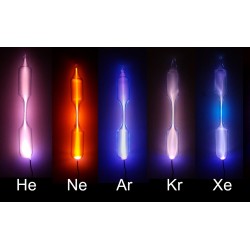Neon
Neon, with the chemical symbol Ne, is a colorless, inert noble gas and belongs to the noble gas group in the periodic table. It was first discovered in 1898 by the British scientists Sir William Ramsay and Morris Travers, who isolated it from liquid air. The name "Neon" is derived from the Greek word "neos," meaning "new."
Although neon is the fifth most abundant element in the universe, it is exceedingly rare on Earth, constituting only about 0.0018% of the Earth's crust. Due to its low reactivity, neon is often used in gas discharge lamps, particularly in neon lights, to produce vibrant, luminous colors.
Exciting applications of neon span across the lighting industry, advertising, and art. Neon lights are employed for vivid signage and artistic designs. In the future, innovative applications could arise in laser and plasma research as well as in space exploration. Neon might also find application in advanced cooling systems and medical technology. Despite its limited availability on Earth, neon remains of interest due to its unique luminescent properties and potential future applications.











